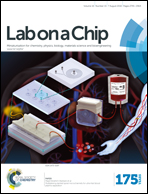Magnetic domain wall tweezers: a new tool for mechanobiology studies on individual target cells†
Abstract
In vitro tests are of fundamental importance for investigating cell mechanisms in response to mechanical stimuli or the impact of the genotype on cell mechanical properties. In particular, the application of controlled forces to activate specific bio-pathways and investigate their effects, mimicking the role of the cellular environment, is becoming a prominent approach in the emerging field of mechanobiology. Here, we present an on-chip device based on magnetic domain wall manipulators, which allows the application of finely controlled and localized forces on target living cells. In particular, we demonstrate the application of a magnetic force in the order of hundreds of pN on the membrane of HeLa cells cultured on-chip, via manipulation of 1 μm superparamagnetic beads. Such a mechanical stimulus produces a sizable local indentation of the cellular membrane of about 2 μm. Upon evaluation of the beads’ position within the magnetic field originated by the domain wall, the force applied during the experiments is accurately quantified via micromagnetic simulations. The obtained value is in good agreement with that calculated by the application of an elastic model to the cellular membrane.



 Please wait while we load your content...
Please wait while we load your content...